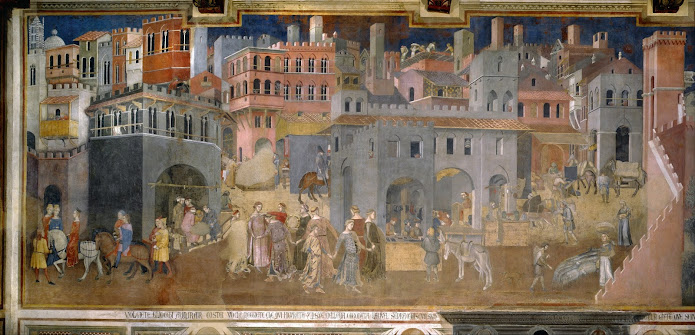Italian Renaissance
 |
| Effects of Good Government in the City |
“Sala Della Pace” or "The Effects of Good Government in the City and in the Country”, was created by Ambrogio Lorenzetti’s in Siena, Italy during 1338-1339. These murals on the walls of a display room that portray an allegory of the government’s influence on the people, city, and countryside. While this may seem a bit early for the Italian renaissance, this was one of the early works that focused on some signature characteristics of the Italian renaissance, as well as humanism aspects.
 |
| Allegory of the Good Government |
The return of humanistic ideals into the mainstream of art during this time had a lot of the same elements of past art pieces but applied more towards humans (body, size, overall atmosphere). I feel something artists did at this time was bridging the gap between more religious works, making it more relatable. The churches liked this and to keep the religious work going, ended up paying artists a good amount of money to create work that was to be displayed at their religious establishments. “Sala Della Pace” had plenty of nods to the more religious ideas while being largely focused on the people and the place; more humanistic.
 |
| Effects of Good Government in the Country |
Some history about these murals, is that they are the "first and only secular painting of siennas early Renaissance period."¹ And when those governing Siena commissioned this, they wanted it to be a guid to everyone so they would know what would happen if they don't properly govern the place.
Structure and Statement
This mural was split into six sections, showing depictions of what the city and country would look like when the government is working as intended, but it also showed what it would look like if the rulers were taken over by things like tyranny and pride. This allegory of good and bad government served as a guideline for what things should look like when going right and served as a warning for what it would look like if ruled poorly. There are good signs like prosperity, construction, business full of people and happy gatherings, these are good things built off of balance. The allegory of bad government shows violence, corruption, fire, broken building, chaos and more things that are a threat to an orderly place.
 |
| Allegory of the Bad Government |
 |
| Effects of Bad Government in the Country |



I can't imagine the effort that was put into making this mural. It was smart of the church to commission artworks though to push their ideals forewards. I gotta say I appreciate the small numbers you dotted throughout your blog that relate to the sources. It makes cross-referencing very easy. This seems live a very interesting piece to check out.
ReplyDeleteThis piece is very interesting! I think that it is very interesting how there are different panels to represent different situations. The contrast specifically between the good and bad government in particular is fascinating. I appreciate that you chose an earlier work to showcase! It is nice to be able to see the way that artwork changed over such a long period of time.
ReplyDeleteI've never seen this artwork before, but I do enjoy it! It's really interesting how each of the six sections depict different scenarios and locations. I really appreciate your breakdown of each of the section, as you furthered the information by describing the influence of religion and government, and the influences that lead to this piece.
ReplyDeleteInteresting blog, it reminds me of Last Supper in Milan, the painting is contained in the church Santa Maria delle Grazie in Milan, which is displayed in the dining hall of the convent.
ReplyDeleteI tried to write a blog about it, hope you also like it in https://stenote.blogspot.hk/2018/03/milan-at-last-supper_3.html